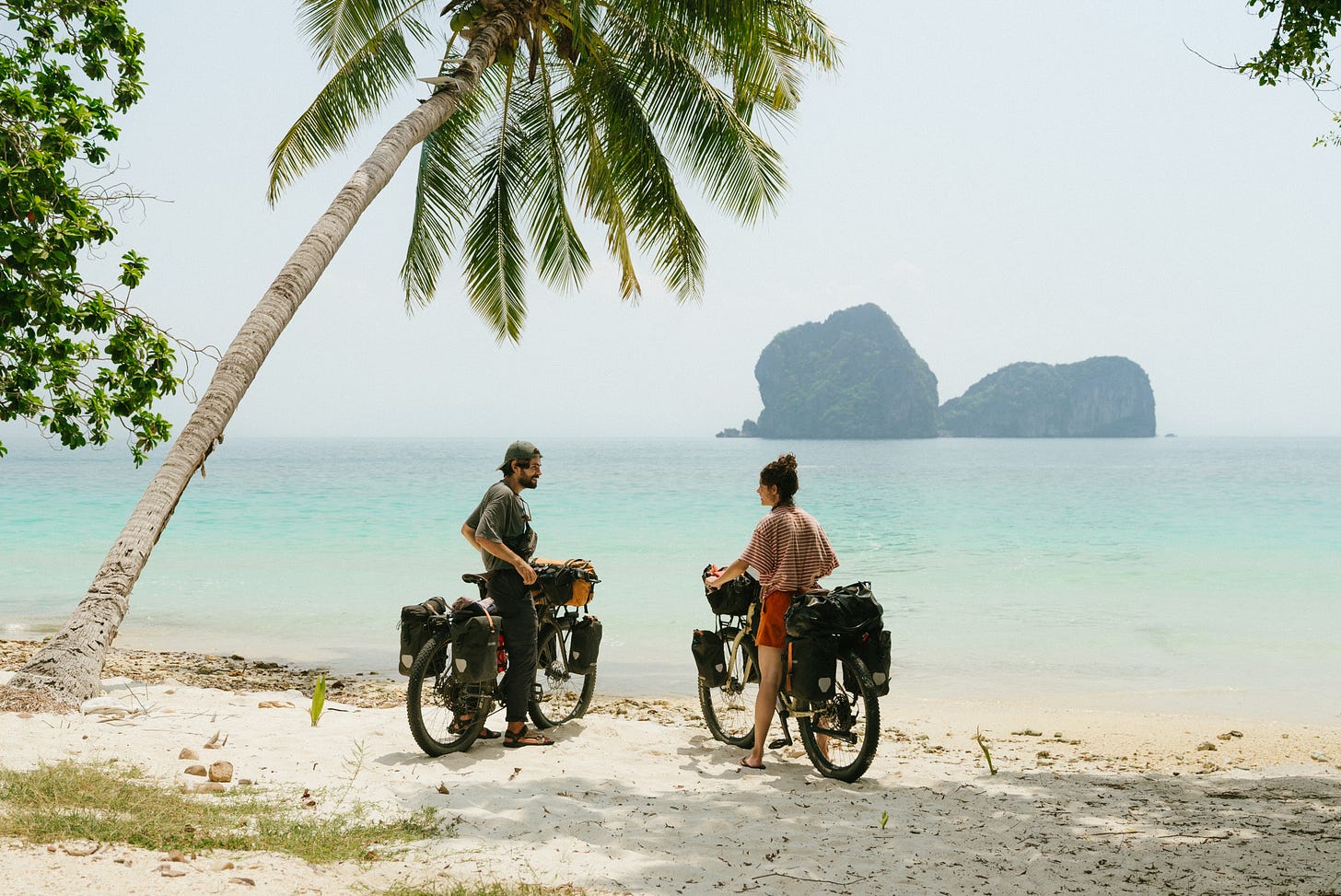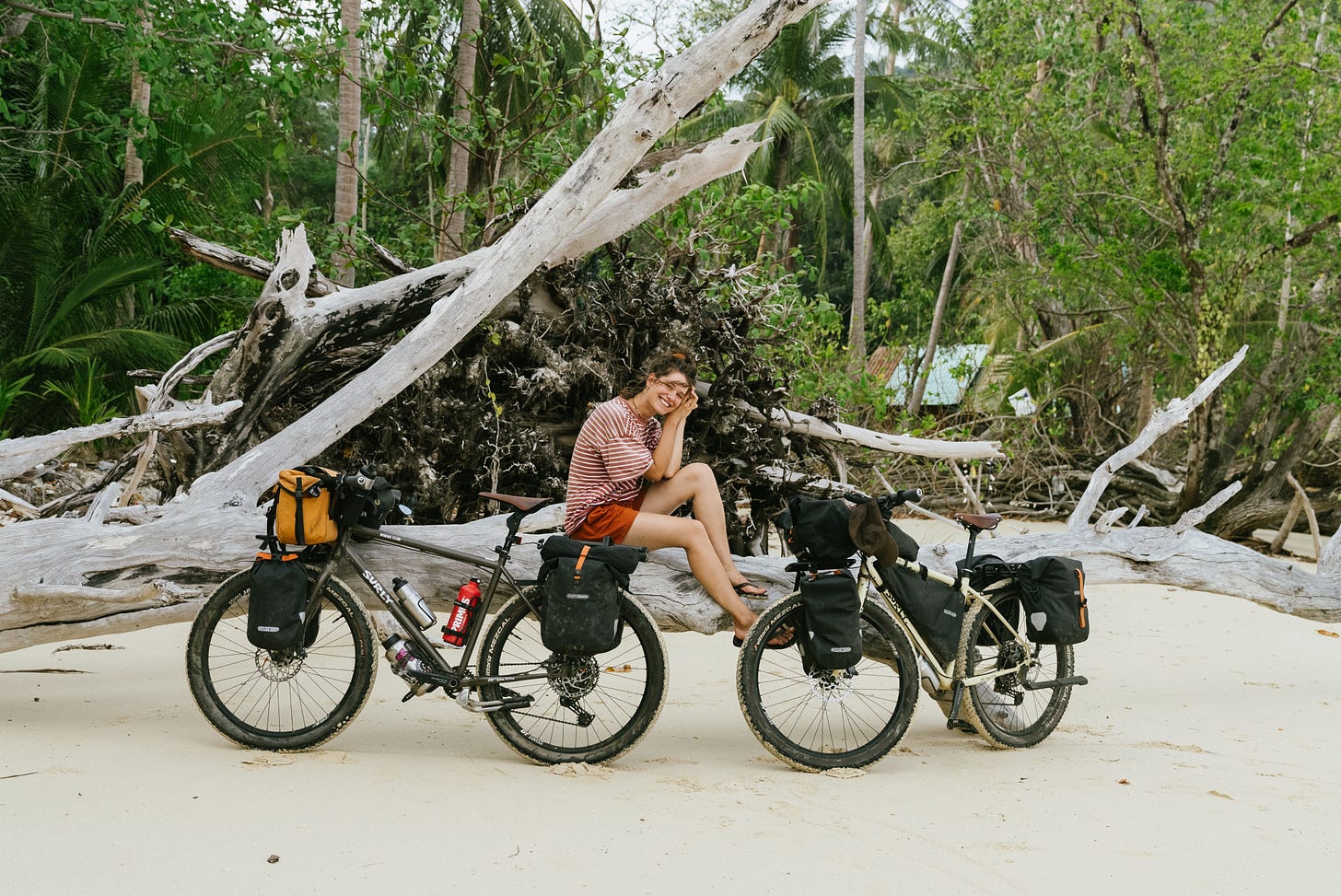Island hopping in Thailand
Some mall moments and impressions that stayed with us.
Thailand is known for its beautiful islands — so of course, we had to take a look. We planned a route from Satun to Phuket, hopping from island to island, aiming to visit six of them along the way. Some crossings were a challenge, but as I’m writing from Phuket, I can proudly say that we made it!
The video gives you a twenty minute impression of the two weeks it took us to tick them all off. In this article, I’ll dive into more details — small moments and impressions that stayed with us.
So, ready to join? Let’s go!
Koh Muk
As we arrived at the pier on Ko Muk, we thought we saw a giant oil slick in the ocean. It turned out to be a school of dozens of fish, moving in perfect sync through the crystal-clear water. We were mesmerised and wanted to be part of it, so dipped a toe in, only to realise that the Andaman Sea feels like a hot spring — it can reach 30°C! A refreshing dip is out of question, but you won’t hear us complaining.
Just before hopping onto our bikes to explore, a quick bathroom stop reminded me that, yes — we were on an island. Sand poured down my legs like water. Minutes later, it had made its way into my hair, slipped into my bags and somehow even infiltrated our snack stash. Our unsalted peanuts turned into salty ones.
The island life took a little adjusting, but those tiny inconveniences quickly became part of the charm.
We racked up quite a few kilometers on Koh Muk, which consists of less than eight square kilometers. It’s small, but just big enough to cycle around. The mopeds and tuk tuk traffic felt overwhelming at times, but it was nice to see that this island finds a good balance between tourism and local life. The authentic feel is definitely thanks to the hospitality of the people living there.
This island introduced us to our Thai food crush: Massaman Curry. To this day, we flip open every menu hoping to spot it. If this rich, nutty, creamy stew is on there — decision is made. No need to look any further. With the discovery of this dish, we’ll often look back warmly on this small but charming island.
After three days on Koh Muk, we were ready to move on — and that brought us to Koh Kradan!
Koh Kradan
With less than 3 square kilometers, Koh Kradan was the smallest island on our route. And although cycling was quite impossible there, it still left a warm impression on us.
We met Mix, a seven-year-old of Italian and Thai roots, in the heart of Koh Kradan’s jungle. His parents run an Italian restaurant and resort there. The place is enclosed by tropical trees, which made it a comfortable spot to escape the sun during the hottest hours of the day.
Mix proudly gave us a lesson in folding paper cars and we spent hours crafting together. Talking with him gave us a sense of his life on the island. There’s no school, so he takes online classes. He doesn’t have any friends, but stays in touch with many of the tourists who visit. Though it seems isolated, Mix’s outgoing personality allows him to interact with many different people and cultures.
Meeting him gave us a taste of the authentic Koh Kradan. That said, the island is clearly focused on tourism. Though we usually prefer local places, we did enjoy the beautiful beaches. There's no getting around it: it just looks like a paradise out there.
Our bikes, however, strongly disagreed. With only one trail crossing the jungle, we quickly found ourselves going in circles. We were stared at a lot and felt pretty exposed, especially with our squeaky brakes — thanks to the salty water. And honestly, I get it: bringing bikes to a place where cycling is impossible was a bit silly. However, our massive tires actually made it work to bike on the beach.
We spent the night at a little campsite — something we hadn’t expect to find on such a small, touristy island, packed with expensive resorts. But we did, and ended up sleeping on a grassy patch with a sea view — for less than the price of a bottle of water.
On our last morning, we wanted to say goodbye to Mix, but his father told us that he had gone fishing at 4:00 AM. Clearly, he was living the island life. We’re curious to see how this young man will grow and evolve. Who knows, maybe one day we’ll cross paths again, when he’s captaining a boat instead of folding paper cars...
Koh Ngai
From Koh Kradan, we moved on to Koh Ngai (still not sure how to pronounce that).
Once again, this island is mainly home to tourists or locals working in the resorts. It’s a beautiful holiday destination, but with a bit less of that authentic feel.
For six euros, we pitched our tent on a tropical patch of jungle, tucked beneath an army of palm trees. We picked the one spot with the lowest coconut-to-head risk and settled in with a card game and snacks.
That night, however, we nearly cooked ourselves. The heat was unbearable, and with the mosquitoes around, sleeping outside was out of the question. It was a struggle, but it led to the discovery of what we now call the ‘don’t burn alive in your tent life-hack’.
Here’s how it works: take a cold shower (in any form), leave your clothes on, skip the towel and dive straight back into your tent. You’ll cool down, fall asleep quickly and suddenly the night doesn’t feel endless anymore.
Camping in Asia is beautiful, with a small hiccup now and then. We take it as it comes and get to discover our ways to deal with it.
On to the next island: Koh Lanta!
Koh Lanta
Koh Lanta, covering about 80 square kilometers, was the largest island we visited. On this island we were clearly being punished for the days we barely cycled. It’s hilly landscape was no walk in the park, but at least we could cycle again! No complaints there.
After a quick tour around the island, we made our way to the old town district. This is where we stayed for a few days to get some work done. We stumbled upon a bakery selling sourdough bread. Although we’re still far from tired of Asian food, a proper slice of bread just hits the spot. Especially for Bernardo, who — being Portuguese — has a deep-rooted appreciation for good bread. Portugal just knows how to make bread right, and he misses it sometimes. In this little bakery, his craving was quickly satisfied.
On Koh Lanta, we got to witness Iftar: the breaking of the Ramadan fast. Local families happily gathered in the streets to share food and celebrate. With over 80% of Koh Lanta’s population being Muslim, it brought a lovely sense of life and community back to the public space.
With all due respect, we enjoy seeing that kind of energy in the streets again. During Ramadan, the streets had been quieter, with many restaurants being closed. And since we’ve experienced such warmth and openness from the Muslim community, it feels good to see them out and about again.
Koh Lanta was where we realised just how important interacting with the native people is for us. We both acknowledged that we sometimes longed for the authenticity of the mainland, where conversations just happen and nothing feels forced. On the islands, it feels different; the locals, so used to tourists, make it harder to form those real moments. And its’s those moments that give a place meaning to us.
But before we could fully reflect on that, there were still two islands left to explore. We were curious to see what they had in store!
Koh Yao Noi
Koh Yao Noi delivered the perfect balance: cozy feel, beautiful beaches, plenty to explore, yet still small-scale and authentic. And, the cherry on the pie: bike-friendly roads! This might just be my favorite island of all.
Since we kept spotting a new, charming little restaurant every time we tried to stop, we decided to split up our lunch and sample a few different places along the way. This perfectly reflects the island’s laid-back and cozy vibe.
We attempted to reach the island’s most beautiful beach up north, but as the landscape turned into a sea of hills and the skies erupted up with a rainstorm, we turned around. We headed back to town in search of shelter, which we found — once again — under a pergola (we love those things). That’s where we pitched our tent and spent the night.
As usual, we had locked our bikes together for the night. But the following morning, the key had mysteriously vanished. We still blame each other.
Fortunately, the tragedy was short-lived. Bernardo found a garage, an angle grinder and a helpful man, who gave him a ride on his moped to ‘the crime scene’. Although Bernardo was eager to drill through the lock himself, the helpful man took care of it. A happy ending after all.
Koh Yao Yay
Just a stone's throw away from Koh Yao Noi, you'll find its bigger brother: Koh Yao Yai. We thought about swimming there, but couldn’t just leave our bikes behind, so we took the boat instead.
On this island, we found the most beautiful beach of all the islands we visited. You can see it in the intro of the video, how at low tide, a sandbank emerges, stretching out in a shape that cuts through the turquoise water. Of course, we couldn’t resist riding our bikes a few meters across it.
There’s an abandoned house on this beach, where we spent two stormy nights. It sounds creepy, and honestly, it was. Lightning flashes blinded us and liters and liters of rain poured down. We had to put in earplugs to block out the overwhelming noise of the rain, hitting the metal roof.
That’s part of life on a tropical island. And it was all worth it for the mornings we woke up there; without a cloud in the sky and as the only souls around, enjoying this beautiful piece of earth.
After six islands, we’ve drawn the following conclusion: Island-hopping was an adventure we wouldn’t trade for anything, but it also made us value the mainland rides even more. We find it easier to connect with the local people there and feel more fulfilled if we can make real ground, instead of pedalling in circles.
But again, with everything this journey has given us — the people who helped us hop from island to island, the adventure that came with it, biking across beaches and returning with beautiful footage — we wouldn’t have done it any other way.
We’re happy with this little piece of Line On A Map.
Thanks for coming along with us :)
Jule Noah





I love your writing, it is so charming! ☺️
Beautiful